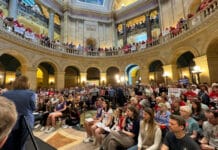We are in an unprecedented time where a virus has taken hold of the world. And it appears as if politicians around the U.S. have latched onto the virus in a partisan fashion. A map of “open” and “not open” states is directly paralleled to a map depicting red states and blue states.
Gov. Tim Walz, a blue state democrat, has followed in step with like-minded governors across the country. Putting aside the delay in opening up certain businesses after closure to flatten the COVID-19 curve, Gov. Walz’s “indefinite” date to open up churches has caused concern for many. So much so that the Catholic Bishops of Minnesota and Lutheran Church (Missouri Synod) said last Friday they would defy the governor’s order for church closure. Beginning on May 26, the churches said they would resume services with a limited occupancy of 33% and safety protocols followed. All this backed by a potential lawsuit should the Governor not lift the order for a 10 person church capacity. Also last week, President Trump declared houses of worship essential.
This push back prompted Gov. Walz to “turn the dial” and announce in an impromptu press conference on Saturday that he “would allow” churches, while paying especially high homage to mosques and the Islam faith, to open at 25% capacity starting May 27. This was a welcomed start to normalcy in Minnesota. But spirits were tempered when Jan Malcolm, Minnesota’s commissioner of Public Health, stated that the continued loosening of the imposed restrictions will depend on how well Minnesotans “hold these new behaviors as our new normal” moving forward.
Gov. Walz, in teacher fashion, last assigned the state a “D” in their ability to social distance. This doesn’t leave the churches a lot of hope to return to capacity anytime soon.
Some may say this is a form of religious oppression that seems hauntingly familiar to the founding of our country.
Gov. Walz has been erecting walls that won’t likely come down anytime soon between the people and their freedom to worship.
The wall between people and religious freedom
As churches remain closed to full capacity and to function as they should, feeding the hungry and tending to the social and emotional needs of their people, liquor stores have remained open.
One Minnesota pastor, who has met “underground” for weeks with his congregation on Sundays within the church walls declared, “We can take care of the people better than the liquor stores!”
A main catalyst for the launch of our country was the oppression of free worship by the Church of England. The Library of Congress will tell you the colonists “refused to compromise passionately held religious convictions and fled Europe.”
Another catalyst was economic freedom. In some regards, today’s churches and businesses can be compared to the puritan and pilgrim dissidents who sought religious freedom and economic opportunities in what is now the United States.
It seems both of these oppressive conditions are in place today in Minnesota due to the Governor’s edicts. The Catholic Church, Missouri Synod Lutheran Church and struggling bar/restaurant owners have shown us this.
The wall erected by Gov. Walz standing between the people and religion is an obvious one, but there are other walls that may not be so obvious.
A wall between the people and government
When COVID-20 comes around, many will be wondering, “What kind of restrictions will the government impose next?”
Governing was never intended to put up walls between the people and those in leadership, but that is exactly what is happening through the COVID-19 crisis. Many middle of the road and armchair quarterbacks when it comes to politics, have now become Libertarians, questioning the government and their logic.
And just as not all institutions and businesses are equal (Minnesota’s Largest Candy Store compared to churches/restaurants/bars/
Nationally, North Dakota, South Dakota, Iowa, Nebraska, Wyoming, Utah, Oklahoma, and Arkansas have remained open. As compared to neighboring states who chose to stay open, Minnesota’s death rate is higher than those of any of the listed states at 16 per 100,000 residents. Comparably, North Dakota is at 7, South Dakota is at 7, and Iowa is at 14 deaths per 100,000 as of May 25. The other open states have the following death rates per 100,000 as of May 25: Wyoming, 2; Nebraska, 8; Utah, 3; Oklahoma, 8; and Arkansas, 4.
One may question comparing Minnesota, ranked 30th in the country for population density (the total population divided by land area), with South Dakota who is ranked toward the bottom of the 50 states at 46. However, Minnesota, whose population density is 69, can be compared to West Virginia whose population density is 76.6.
West Virginia’s stay-at-home order expired on May 3, and Gov. Jim Justice lifted restrictions starting on May 4 for malls, retail stores, food and drink restaurant dining, salons, barbershops, tanning salons, outdoor and recreation gyms, recreation centers, state parks, and campgrounds, among other businesses.
West Virginia’s death rate is 4 deaths per 100,000 as of May 25.
Additionally, 80% of the Minnesota deaths have been in long term care facilities, which have had strict lockdown procedures.
The wall between people and ‘life, liberty and the pursuit of happiness’
When COVID-19 has another surge or when COVID-20 comes around, many will also be asking themselves, “Is a shutdown of ‘life, liberty and the pursuit of happiness’ going to happen again?”
Not only has Minnesota’s leadership come between its people and themselves, but now they have become a threat to many businesses in Minnesota.
Minnesota Attorney General Keith Ellison recently filed a lawsuit that could come with a $25,000 fine at minimum against an Albany bar owner, Kris Schiffler, who said he was going to open his business on May 18. Ellison also sought a restraining order against Schiffler to prevent him from opening his business.
House Republicans sent a letter to Attorney General Keith Ellison calling on him to “stop threatening businesses, faced with a choice between opening and going out of business, with hefty fines and legal action.”
Minneapolis Mayor Jacob Frey issued an order closing all pools and beaches for the summer and now says children as young as two years old are required to wear facemasks in all indoor facilities, backed by a $1,000 fine for non-compliance.
Unemployment is at an all-time high, and when people are able to go back to those jobs, they may not have a job to go back to. This has caused many to become despondent, even to the point of suicide and increased drug and alcohol addiction. The Governor’s actions have now become a threat to life, liberty and the pursuit of happiness.
Gov. Walz’s walls now also make us question our higher institutions.
The wall between people and trust in higher institutions and health officials
The original model which influenced the Walz administration was designed by the University of Minnesota’s School of Public Health, along with the Minnesota Department of Health, and predicted 50,000 COVID-19 deaths if the state had done nothing … and 22,000 deaths over the course of the year if we did something.
Now we are on Model 3.0, a revised model that continues to be used as a tool to chart policy in response to COVID-19. Model 3.0 predicts 29,030 deaths by June 29 and 1,441 deaths by May 31. Currently, we are at 881 reported deaths in Minnesota, with 717 of them occurring in long term care facilities.
If model 3.0 is correct, that will mean there will be 560 additional deaths in a six day period or 93 deaths per day by May 31.
However, there has been a gradual decrease in the death count per day since May 22 when Minnesota saw its biggest spike in deaths with 33 in one day. Since then, there have been 10 deaths recorded on May 23, 17 deaths recorded on May 24 and 12 deaths recorded on May 12.
Projecting to June 29, according to Model 3.0, the state will see 804 deaths per day if this model is accurate.
Minnesota Department of Health Commissioner Jan Malcolm admitted that there is a “divergence” between the models they’ve used that predict the cases the state will have. We will see how much of a divergence as time progresses.
What next?
Is Ronald Reagan’s statement correct when he said in his first inaugural address, “In this present crisis, government is not the solution to our problem; government is the problem”?
Will we learn from this event or will this be just the beginning to beating people into compliance with the government? Will our Constitution be thrown by the wayside whenever a suspect virus rears its head?
The fallout for Gov. Walz will be one he may never recover from. Despite the recent Star Tribune/MPR poll stating two-thirds of Minnesotans support the Governor’s actions, all one needs to do is take a closer look at the comments on those posts to see their poll is erred. Perhaps Gov. Walz will take heed from the comment sections of these posts and the will of the people, rather than the echo chamber that is Minnesota mainstream media.
Sources:
-
https://www.statista.com/
statistics/1109011/ coronavirus-covid19-death- rates-us-by-state/ -
https://www.nytimes.com/
interactive/2020/us/states- reopen-map-coronavirus.html -
https://mn.gov/covid19/assets/
MNmodel_PPT_tcm1148-427787.pdf -
https://abc7news.com/suicide-
covid-19-coronavirus-rates- during-pandemic-death-by/ 6201962/
T.A. LeBrun


















